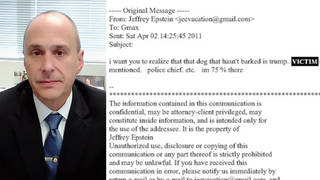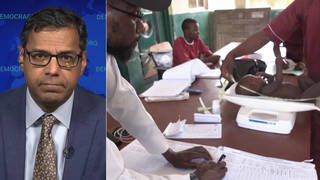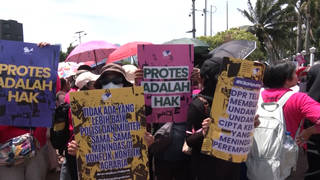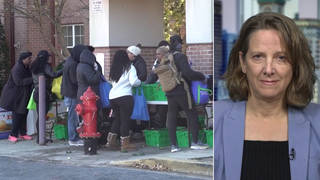
Topics
The disaster is killing thousands in Aceh but the Indonesian military has been doing that for years. Now activists fear the Indonesian military will use the disaster as a cover to further the killing of the Acehnese and that the Pentagon may use the disaster as an excuse to restore aid to the Indonesian military which was blocked after the military’s massacre in East Timor in 1999. [includes rush transcript]
- Suraiya I. T. , Chairperson of the International Forum for Aceh
- Allan Nairn, Journalist and Activist
For more information and to make donations for the grassroots relief effort:
Transcript
AMY GOODMAN: Today, we are joined in our studio by Suraiya I.T. She heads up the International Forum on Aceh. She is Acehnese herself. We are also joined by Allan Nairn, activist and journalist, who has just recently come from Indonesia and has spent a good deal of time in Aceh. We welcome you both to Democracy Now! Suraiya I.T., let’s begin with you, how is your family in Aceh now?
SURAIYA I.T.: My family is fine because my mother lives in east of Aceh, because east of Aceh is okay.
AMY GOODMAN: What are you hearing about Banda Aceh and the areas hardest hit.
SURAIYA I.T.: I just heard from the NGO coalition from Aceh. The situation is getting worse because of the victims are increasing, and the supply of medical aid is very limited, and the supply of what’s limited also.
AMY GOODMAN: What are the numbers that you’re hearing in terms of the numbers of people dead?
SURAIYA I.T.: Just in Banda Aceh is sad. The number until now is more than 30,000 people were dead. Not yet from west of Aceh, Meulaboh because of the communication problems, because of transportation problems, so, we cannot exactly [know] how many people. Maybe it’s according to the people in the ground, almost 60,000 people were killed in the whole Aceh.
AMY GOODMAN: 60,000 alone.
SURAIYA I.T.: 60,000.
AMY GOODMAN: Which are higher than the figures that we are hearing at this point.
SURAIYA I.T.: Yes, yes, yes.
AMY GOODMAN: Is medical aid getting to the people?
SURAIYA I.T.: According to the people on the ground, because they just called me three — three in the morning this morning. I asked them, how about the medical aid? According to them, actually, it is — the aid —- so many aids came from outside the country, but the problem is stuck in the Halim airport now. So the medical assistance, the medical aids cannot enter to Aceh, first because of the military operation in the first, and secondly, totally no medical system in Aceh. And about the scene yesterday, the government officially announced that journalists and foreigners can enter Aceh. However, because of transportation, because of the situation getting worse, they cannot just come into Aceh, because of the transportation, the aid starts in Halim airport and in Medan, so -—
AMY GOODMAN: So, can medical people, can relief freely make their way into Aceh?
SURAIYA I.T.: Seems yesterday, yes. However, like I told you, because of transportation, because of the system, they cannot enter directly to Aceh right now, because flight is very limited, because of the transportation from Medan to Banda Aceh is very limited also.
AMY GOODMAN: Is the Indonesian military there?
SURAIYA I.T.: Yes. The problem is, according to my perspective, the coordination is very bad because of government, not good coordination to concentrate about the transportation problem. I think it’s very, very bad because of the coordination is very bad in Aceh.
AMY GOODMAN: We are also joined by Allan Nairn, journalist and activist, just recently returned from Indonesia, has spent a good deal of time in Aceh. Allan, what are you hearing?
ALLAN NAIRN: As Suraiya said, the military, until about 24 hours ago was impeding international aid agencies from coming in. There was a team from — a medical team from Japan that flew in, and turned around in frustration because the military wasn’t letting them enter. This is undoubtedly caused thousands of extra deaths. The reason the military won’t let them in is that Aceh has been under semi-totalitarian de facto occupation by the Indonesian military. On TV, people may have seen footage of the Grand Mosque of Banda Aceh, one of the few big structures left standing, and in the yard in front of the mosque, it’s litters with bloated bodies and dead animals, and debris and the building itself is cracked. It’s now a scene of devastation. But just five years ago, the yard in front of that mosque was filled with anywhere from 400,000 to a million Acehnese who were carrying out a peaceful demonstration calling for referendum. A vote — a free vote in which they could choose whether they wanted to become independent of Indonesia. In proportional terms, Aceh has a population — before this disaster, had a population of about four million. This means that anywhere from 10 percent to 25 percent of the entire population of Aceh, turned up on the lawn of the mosque that day, to call for freedom. It’s — proportionally, it’s one of the largest political demonstrations in recent world history. If a similar thing happened in the US, you’d be talking anywhere from 30 to 60 million people here to give an idea of the enormity. Faced with that kind of civilian movement, the Indonesian military moved to crush them, assassinating, disappearing leaders, raping female activists. Jafar Siddiq Hamsa, who was a leading international spokesman for the Acehnese — he was becoming to Aceh what Jose Ramos Horta was to East Timor. Jafar lived in the US for a few years. When he went back to Aceh in 2000, he was abducted, his body turned up wrapped in barbed wire, multiple stab wounds in his chest, his face sliced off. The military wants to crush the civilian movement in Aceh because they know they can’t win a political fight. They prefer the military fight. There is an armed rebel group in Aceh, the GAM, the Aceh Independence movement. The military occasionally sells them weapons. They wants this war to continue. It enables them to make a political point. They say to people and the rest of Indonesia, see, there is danger and chaos. You need us, the army, to protect you. Who else can you turn to? And secondarily, the fighting in Aceh gives the Indonesian military and police a gold mine of corruption. The — there is a system of police and army extortion of the poor and small businesspeople. Every week, you have to turn over 10,000, 20,000, 30,000 rupia, the equivalent of a couple of dollars. You cannot drive on the road without being shaken down. And people are not free to move within Aceh. It’s one of the worst situations of repression in the world, and the Indonesian military wants it to continue that way.
AMY GOODMAN: We have to break. When we come back, we’ll talk about what this occupation and the tsunamis mean together at this point with Aceh, ground zero of the global calamity that is currently unfolding, now hearing up to 70,000 people killed, estimates that it will be over 100,000 people killed. Our guests, journalist Allan Nairn, and Suraiya I.T. of the International Forum on Aceh.
[break]
AMY GOODMAN: We’re talking about ground zero right now, about Aceh, Indonesia, the site of two catastrophes, one the natural calamity, and the other the military occupation that has gone on for years. Our guests, Suraiya I.T. of the International Forum for Aceh as well as journalist and activist, Allan Nairn, who has just come out of Indonesia and has spent a good amount of time in Aceh. Allan, as you talk about the political situation in Aceh, the military now looking like the people who will help those in Aceh, whoever has survived.
ALLAN NAIRN: Well, the military just announced they’re sending in 15,000 additional troops into Aceh. They undoubtedly will use the new situation where people — Acehnese will be coming home, many of whom are in exile will try to come home to search for the dead, bury the dead, see what remains of their houses. It’s likely that Indonesian military intelligence will be using that to target people. Just two days before the quake, the military announced that they were sending 4-500 additional military intelligence people into Aceh. The Indonesian military intelligence is now funded by the American CIA Under the guise of anti-terrorism, even though by an objective definition of terrorism, killing civilians, more than 95% of the terrorist acts in Indonesia have been carried out by the military. When the quake hit, buildings collapsed, prisons collapsed. The woman’s prison, down near the water in Banda, Aceh collapsed. Many of the victims were political prisoners. People who were in there only for the crime of expressing hatred against the government, which is actually prohibited. They were jailed without evidence. The thousands, many thousands of Aceh, even before the quake and tsunami were driven off the land by the military, and many were put into reeducation camps, where they were indoctrinated and sorted by the military. Now people are being dumped into mass graves. This has actually been going on for years in Aceh, except prior, the mass graves came from military bullets.
AMY GOODMAN: Now, Aceh, this area, is the largest gas fields run by Exxon Mobile?
ALLAN NAIRN: There’s a huge natural gas operation centered near the town of Lhoksumawe. It supplies much of the natural gas for Japan and South Korea. There’s no good reason why Aceh should be poor. Even though most of the people living along the coast, who lost their homes and their belongings, and their farm animals, were living a very poor life. This massive natural gas operation, the revenues accrue to Exxon Mobil and the central government in Jakarta, and almost none finds its way back to the people of Aceh.
AMY GOODMAN: I remember reading several years ago a Business Week expose called, “What Mobil Knew.” There was a picture of a man holding a skull. It was about allegations that Mobil had given excavating equipment to the Indonesian military to dig mass graves in Aceh. Suraiya I.T., what do you know about this? I was shocked yesterday hearing a journalist from CNN in Aceh saying, “We are seeing mass graves.” I thought he was talking about those uncovered from the occupation. Of course, he was talking about the newly dug graves where thousands of bodies are being piled in, bull-dozed over, piled in because of the natural catastrophe that has taken place.
SURAIYA I.T.: After the suffering from military occupation, now Aceh has been struck by a natural disaster. Today in the United States and yesterday — yesterday in Aceh, the people bury mass graves in what they call blangbintang — the government provided big area for thousands and thousands of mass graves there. For the Acehnese people, this is like hell for Acehnese — after suffering from mass graves from the oppression, now they suffer from a natural disaster. We lost so many people. The brave people are journalists because more than 200 local journalists are gone and missing — the most brave and dedicated activists are also gone, including Mohammad Ibrahim. He is the director of Walhi — the executive of the Indonesian for whom — for the environment, and like Allan said, many women prisoners and political prisoners, woman activists are gone in the Lhok Nga Prison. And [inaudible], he is a political prisoner, he is [inaudible] inside the prison in Lhok Nga with the 39 women activists, [inaudible] is associate with the GAM member in Aceh. This situation is for the Acehnese people, particularly in Banda, Aceh, such a very, very sad thing because military operations, natural disaster, and this is — how to say — it’s difficult to explain the situation. I call — I called my family. My sister told me, everywhere the bodies are on the streets. It’s very difficult to identify who belongs to whom family this body. Many of the Acehnese either in the United States, either in Jakarta —- why think about the news about their family. Such is the Acehnese in Washington DC. There is bad news now in Aceh, because not just his family gone, but his village is gone also with the -—
AMY GOODMAN: The whole village.
SURAIYA I.T.: The whole village is gone. This is like a deep sorrow for the Acehnese, not just inside Aceh but outside Aceh also. Also, Acehnese in Pennsylvania, the Khalid family for example. He is in deep sorrow also right now because of his sister and five children in Banda, Aceh. So, the situation for the Acehnese now is not just support by what we called aid, but we need support for moral and aid support, particularly for this situation.
AMY GOODMAN: Do many Acehnese live in the United States?
SURAIYA I.T.: Many Acehnese live in the United States. More than 200 Acehnese live in the United States now.
AMY GOODMAN: 200?
SURAIYA I.T.: More than 200 Acehnese live in the United States.
AMY GOODMAN: Allan Nairn, the issue of what this means for the future for Aceh. People now, who run from the military, who are afraid of the military in Aceh, do they turn to the military for support, for finding family members?
ALLAN NAIRN: That’s a good question. Lots of people will have to go to the military for food handouts, to get clean water. In some ways, it will be a situation somewhat comparable to Iraq during the sanctions, when Saddam’s regime was able to control the welfare food handouts. I mean, there’s already a tremendous amount of control, but this can consolidate it even more. On the other hand though, many of the communities are so shattered, the older people, traditional leaders dead, local officials dead, much of the population dead, that to a certain extent, society will have to be rebuilt in many Acehnese towns and that may offer some opportunities. That may offer some opportunities for people to put things back together in a better way than before, but that can only happen if the military pulls back and is not allowed to continue their extortion and their terror. We should put this in perspective. Now the world is looking at Aceh for the first time ever and will probably never again look at Aceh with this intensity, but as dramatic, as awesome as this act of nature is, let’s say it kills 50,000, 60,000 in Aceh, that’s still far less than the death toll over just a couple of years due to hunger and poor nutrition, diarrhea, deaths mainly among children who live in poverty in Aceh. It’s also dwarfed by the military massacres carried out by the Indonesian military in various places. They killed 200,000 in Timor. They killed anywhere from 400,000 to a million in Indonesia itself when they consolidated power in 1965 to 1967. So, the concern that the world has now for this disaster is appropriate, but we should have that concern all the time. When people are dying, not just from natural tsunamis, but from military or police bullets, often paid for by the United States, or dying from preventable hunger. 50 million, that’s what the U.S. is giving. You compare it to Bush’s inauguration, there are also thousands of American individuals who could sit down right now and write a check for $50 million. They could save tens of thousands of lives, but there’s no social pressure on them to do that, because we live in a world where it’s assumed that it’s okay to let people starve while the dollar that can save them sits idly in your pocket.
AMY GOODMAN: In terms of aid right now, where can people help? How can people help the people of Aceh?
ALLAN NAIRN: There are grassroots groups on the ground in Aceh, and we didn’t know until last night that the activists were still alive to carry on, but now we have learned they are, groups like the People’s Crisis Center, which for years have been working with refugees driven off the land, people sent into reeducation camps, trying to give some education to the children, trying to feed. They are now accepting relief, donations. So, people can channel them through either ETAN, the East Timor Action Network in the U.S. The website is www.etan.org; or TAPOL, a human rights organization based in Britain. TAPOL–they’re at www.tapol.gn.apc.org. This money will find its way to grassroots Acehnese activists who are also working for human rights, and will try to save people and build something better in the long run for Aceh.
AMY GOODMAN: Final comment, Suraiya I.T., as we wrap up this discussion to leave with the people who are listening to and watching this broadcast about your people, the people of Aceh.
SURAIYA I.T.: I think that to help the Acehnese people right now, we need support from international community, particularly to encourage Indonesian governments, to open more space for international aid and international journalists. Even right now, the government is opened in the international aid and international organizations, however, there are still regulations and rules, and besides that, we need financial aid from international communities, particularly from the United Nations, from the international community everywhere. They can give support to the mosques, to the churches. We establish the — what we call a Fund Relief for Aceh. They can contact us, either to us or through the International Fund for Aceh.
AMY GOODMAN: We’ll put the contact information on our Web site at democracynow.org. Again, one of those contacts, etan.org. The easiest to remember, etan.org. I want to thank you both for being with us. Suraiya I.T. of the International Forum for Aceh, and journalist and activist, Allan Nairn, who has just come from Indonesia.












Media Options